Introduction
This study examines how exposure to radio advertising on the journey to the supermarket can help brands increase stand-out on shelf and influence purchase behaviour, and explores how these effects can be maximised through creative development and media planning strategies.
The report references new proprietary research conducted by Shoppercentric, a shopper insight consultancy with over 20 years’ experience measuring shopper behaviour. Working with retailers and manufacturers (such as such as Unilever, Nestle, Muller, GSK, Danone, Reckitt Benckiser, Kellogg’s, ASDA, Morrisons, Boots) Shoppercentric provides insight that enhances shopper experiences and enables clients to better communicate with them.
Key take-outs
Radio’s last-minute reach of shoppers boosts on-shelf visibility and purchase intent for FMCG brands
13x times greater than the reach of the next largest editorial media (on-demand audio and social media)
- Getting brands noticed: visibility on shelf increases by 11% among advertised brands
- Reinforcing brand loyalty: purchase intent increases by 30% among repertoire buyers
- Encouraging brand switching: purchase intent increases by 39% among non-repertoire buyers
Putting the learning into practice
The results of this study are evident: beyond delivering broader effects for FMCG brands in terms of awareness, salience, and ROI, radio offers advertisers a chance to exert last-minute influence over shoppers to increase visibility on shelf and drive purchase consideration.
How can marketers optimise these effects?
By up weighting – rather than exclusively focusing – airtime around moments when people are in the car on the way to the supermarket, FMCG advertisers can harness both the last-minute influence of radio and the broader effects of the medium for brands in the sector. This is important because maximising weekly reach was identified as a key driver of return on investment in the ROI Multiplier study.
Radiocentre’s Context Targeter tool uses IPA Touchpoints data to help advertisers identify relevant shopping journey occasions across the day. In parallel, the Cover Curves Generator tool provides top line coverage data based on campaign planning weights for a range of audiences.
Ebiquity’s ROI analysis in Profit-driving radio demonstrates how closely aligning FMCG radio advertising creative with TV can increase ROI up to four-fold. In this study, the brands that performed strongest all benefited from long-running creative campaigns featuring distinctive audio assets.
Using consistent audio branding devices can help advertisers create a clear advantage over competitors: in The Power of You IPSOS revealed that audio branding is 3x as effective as visual branding on average but it is currently used by only 8% of advertisers.
Radiocentre’s Hear and Now study reveals how advertising that relates to activities that listeners are participating in is more engaging and memorable. Referencing the car journey to the shops in the radio commercial could boost radio’s last minute influence effects and help advertisers benefit from an even larger uplift in visibility on-shelf and purchase intent.
Background and Objectives
Radio and FMCG advertising effectiveness
The traditional model of FMCG marketing is brand-led advertising to build salience and exert emotional influence over buyers. Previous studies highlight the significant uplift effects generated by radio advertising for FMCG brands within a wider media mix.
Radiogauge analysis of 169 FMCG campaigns reveals how radio advertising increases ad awareness by 54% and brand relevance by 15% on average.
Radio increases ad awareness by 54% for FMCG campaigns
Average uplift in ad awareness, exposed to radio ads vs. not exposed to radio ads
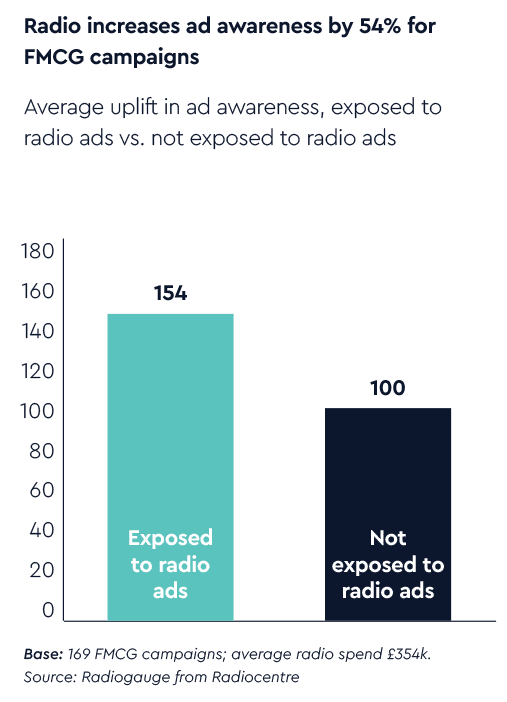
Radio increases brand relevance by 15% for FMCG campaigns
Average uplift in ‘this brand is for people like me’ score exposed to radio ads vs. not exposed to radio ads
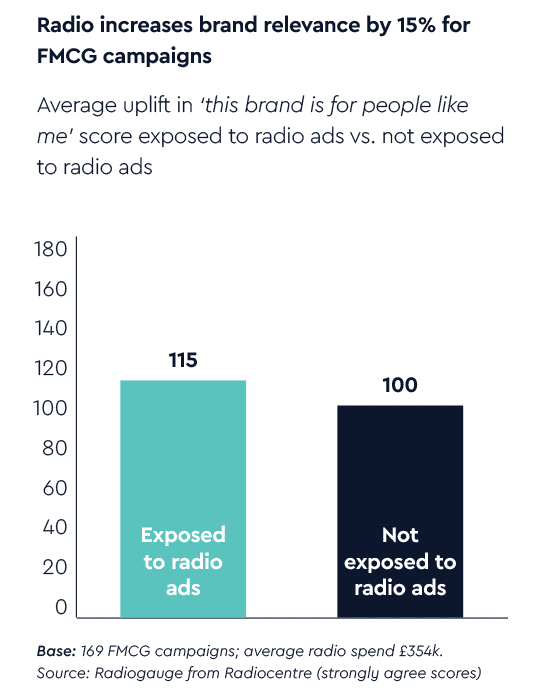
Radiocentre’s study Radio, the Brand Multiplier revealed that, when added to the media mix, radio advertising significantly increases a brand’s network of associations over TV advertising alone, helping FMCG brands spring to mind more readily when people are in buying mode.
Radio advertising expands a brand’s network of mental associations further
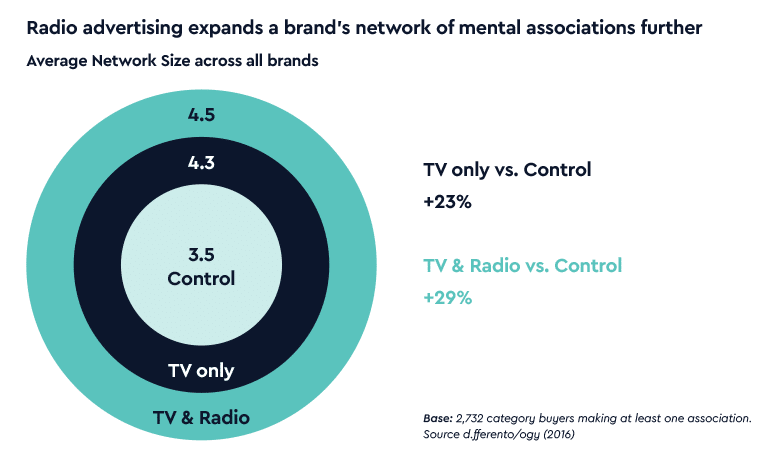
Radiocentre has conducted two studies exploring return on investment from radio: The ROI Multiplier and Profit-driving Radio. Both demonstrate the strong ROI from radio for FMCG brands that can be achieved when creative synergies are exploited. In the ROI Multiplier Study, the top performing FMCG brand achieved revenue ROI of £24.00 per £1 spend from radio, exceeding the best ROI performance of any other medium. Further analysis reveals the importance of creative synergy with TV in achieving this effect – and how allocating budget to radio increases total campaign ROI for FMCG brands.
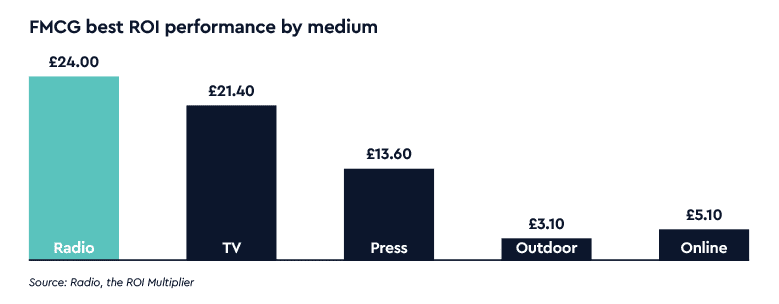
The challenge
With the average supermarket now featuring c. 25,000 SKUs (stock-keeping units), the competition on-shelf for FMCG brands has never been higher. On release of their recent report, The Smart Shelf: Your Pathway to Winning in Retail (Feb 2020), Nielsen encapsulated the increasing competitive challenge for brands in store.
Globally, 60% of shoppers don’t decide on which brand and product to purchase until they’re standing in front of the shelf
On average, 41% of brands in a category go unnoticed
Shoppers only spend 15 seconds in front of any given shelf
The report concludes that “when consumers are uncertain about their purchase choices, manufacturers have a significant opportunity to influence their ultimate decisions”.
How radio can help
IPA Touchpoints reveals that live radio reaches 38% of people in the moment travelling by car to buy groceries, thirteen times greater than the reach of the next largest editorial media (on-demand audio and social media).
This means that radio presents FMCG advertisers with a unique opportunity to intervene and exert last minute influence on buyers to sway their decision making when standing in front of the fixture.
This study was set up to understand these effects in more detail, specifically:
- How exposure to radio advertising on the journey to the supermarket can help brands increase stand-out on shelf and influence purchase behaviour
- How these effects can be maximised through creative development and media planning
How the study was done
With a focus on how radio advertising can influence in-store behaviour, shopper insight consultancy Shoppercentric were appointed to run this project, bringing over 20 years’ experience measuring shopper behaviour for retailers and manufacturers such as Unilever, Nestle, Muller, GSK, Danone, Reckitt Benckiser, Kellogg’s, ASDA, and Morrisons.
Method
Shoppercentric use a range of passive research techniques, such as eye-tracking and emotional response recognition, combined with traditional questionnaires to capture both subconscious and conscious response to different shopping scenarios to help brands and retailers improve the shopping experience.
An important consideration was how to ensure that exposure to radio ads was consistent for every respondent to minimise variables. This would allow us to be confident that any effects were created by the radio advertising and not by other factors.
To address this, Shoppercentric developed a driver point-of-view video of a car journey to the supermarket featuring the car radio playing in the background, with advertising included as a natural part of the audio content.
This allowed for controlled exposure to the radio ads but also meant that they were heard indirectly, as they would be on a typical car journey. It also meant that the ads were heard in exactly the same context/stage of the journey by each participant so the only variable was the advertising featured.
Webcams were used to passively capture second-by-second emotional response and eyetracking as the video of the car journey elapsed, and when participants were asked to observe relevant in-store shelf fixtures. Following this, participants were asked to complete a questionnaire to capture their conscious response to the advertised brands.
The test ads
To ensure that results were broadly representative, radio ads for four brands were selected from a range of grocery categories. Each category was chosen on the basis that it contained enough branded competitors to ensure fair and balanced results. In terms of brand selection, advertisers with relatively current radio ads that focused on brand rather than short-term promotional offers were selected.
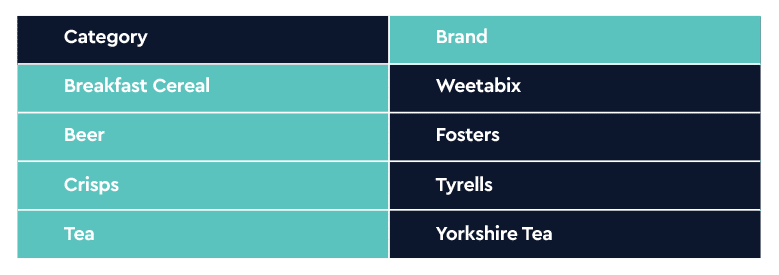
The four brands were split across two test cells and results were compared to a third control cell featuring two non-FMCG ads (Talk Talk; Lloyds Bank) to help isolate the effects of exposure to the FMCG brand advertising.
The total sample, matched across the three cells, was 300 nationally representative commercial radio listeners aged 18-55, all of whom were non-rejecters of the test brands.
Findings in detail
1. Radio advertising that reaches shoppers in-car increases brand visibility on-shelf by 11.3%
In the background to this study we reviewed Nielsen’s data revealing how most shoppers don’t decide which brand to buy until they’re standing in front of the shelf and how the limited time spent in front of each self leads many brands to go unnoticed.
So how can exposure to radio advertising in-car on the way to the supermarket help brands overcome these challenges?
When asked to look at the relevant supermarket shelves following the video of the car journey, the passive eye-tracking analysis revealed that the visual attention of participants exposed to the test ads was drawn towards the advertised brands. On average, visibility of the test brands was 11.3% greater among the radio advertising exposed sample. We can conclude from this that radio advertising primes shoppers to take more notice of brands they hear on the way to the supermarket. But what effects does this have on purchase behaviour?
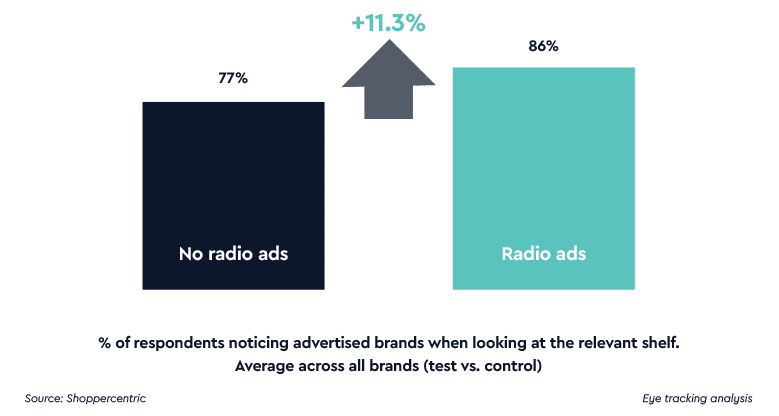
2. Purchase intent increases significantly across all buyers, underpinning loyalty and encouraging switching
After looking at the relevant supermarket shelves relating to the test brands, participants were then asked which of these products they would have bought.
The data shows that radio advertising exerts a significant and powerful effect on purchase consideration in the store environment, increasing overall intention to purchase by a third.
Interestingly, this uplift effect was equally powerful among participants who currently feature the test brands in their purchasing repertoire and those that don’t (but who are non-rejecters of the brands). This suggests that exposure to radio advertising just prior to
Which of these products would you have bought from this shelf?
the shopping occasion can reinforce existing brand loyalty and, additionally, encourage brand switching.
The IPA’s Effectiveness in Context report highlights the importance of both new customer acquisition and targeting existing customers in optimising sales activation results for FMCG brands – so this is an important learning about the effective role that radio can play in helping to achieve this.
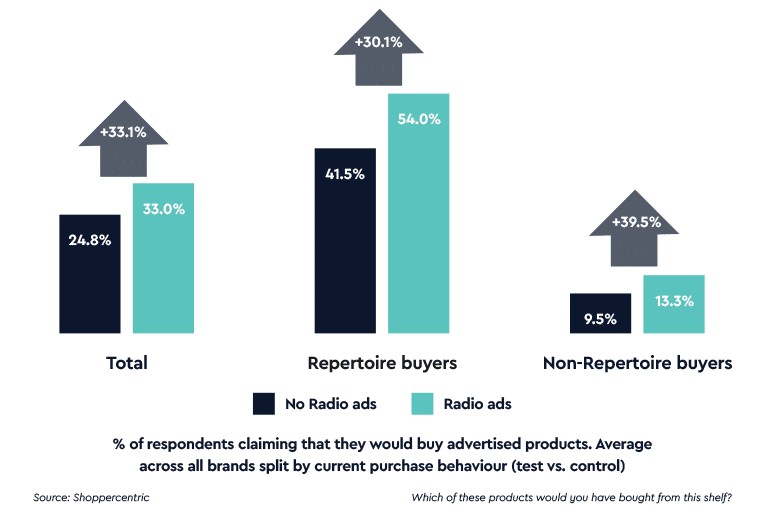
3. Uplifts vary significantly across brands
As with any study of this nature there were significant differences in effect by brand. While the average uplift in overall purchase intent was 33.1%, the top performing brand experienced an increase of almost double this at 65%. At the other end of the spectrum the brand with the lowest uplift only saw purchase intent increase by 4%.
This pattern of effects by brands was broadly consistent across both repertoire and non-repertoire buyers.
Clearly, a large degree of this variation will be attributable to category effects but advertising creativity may also play a role. What can the data tell us about factors that differentiate the better performing ads and what can advertisers learn from this to optimise results from their own campaigns?
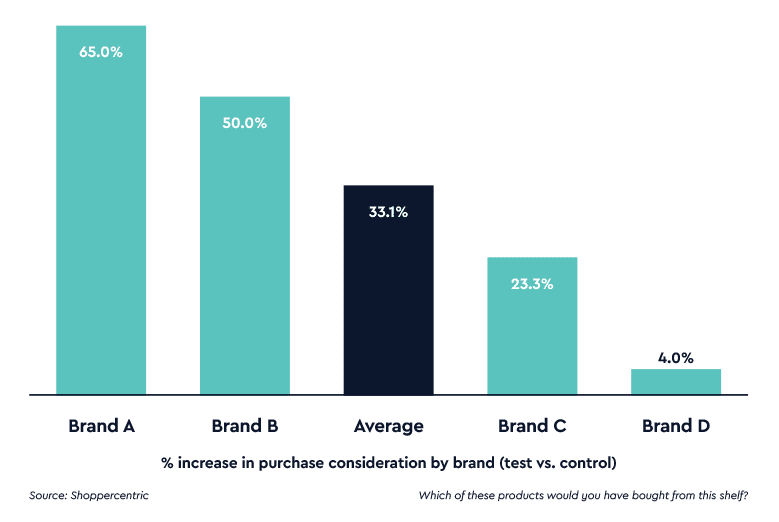
4. The best performing ads stimulate a stronger emotional response
In the IPA study The Long and the Short of It the authors highlight how emotional campaigns produce considerably more powerful longterm business effects than rational persuasion campaigns. Research company System1 have also demonstrated the link between strong emotional response to advertising and more effective outcomes.
To capture emotional response, Shoppercentric recorded the micro emotions involuntarily displayed on the face of each participant as they were hearing the radio ads. Micro emotions are the behavioural expression of neurological response and as such are made spontaneously – their neurological response base means they are universally common to humans regardless of race or culture.
As we can see from the aggregate emotional response score by brand shown in the chart above, the advertising that generated the strongest emotional response correlates closely with higher purchase intent.
FMCG advertisers often use radio creatively to promote rational tactical offers. This analysis suggests that radio effects could be enhanced through greater use of emotional messaging.
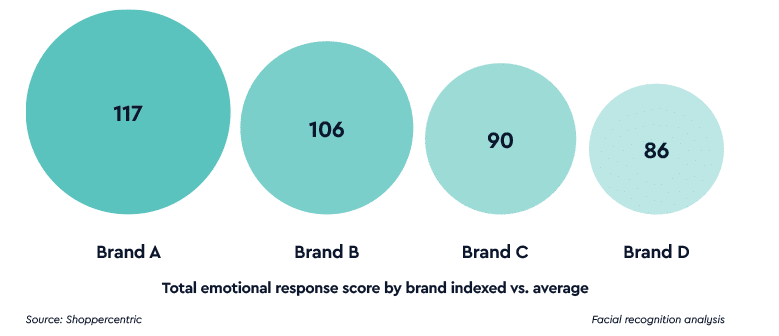
5. Established campaign ideas and distinctive audio assets help optimise effects
Further structural analysis of the radio ads featured in the test revealed that the three best performers were all strongly linked to and consistent with long-running and well-established creative campaign ideas.
This learning is consistent with findings from the Radiocentre study Profit-Driving Radio featuring analysis from Ebiquity demonstrating how profit ROI for an FMCG radio campaign was doubled when the creative work was more closely aligned with that shown on TV.
The effectiveness of consistent audio assets is further explored in the IPSOS Power of You study which reveals how audio branding is three times as effective as visual branding yet is currently used by only 8% of advertisers suggesting that many more advertisers could benefit from taking a more strategic approach to using sound in their advertising.
Brand D was the exception in that it was a relatively new campaign to air. However, the use of audio assets consistently across media suggest that campaign effectiveness will improve over time if this strategy is maintained and the campaign becomes established.
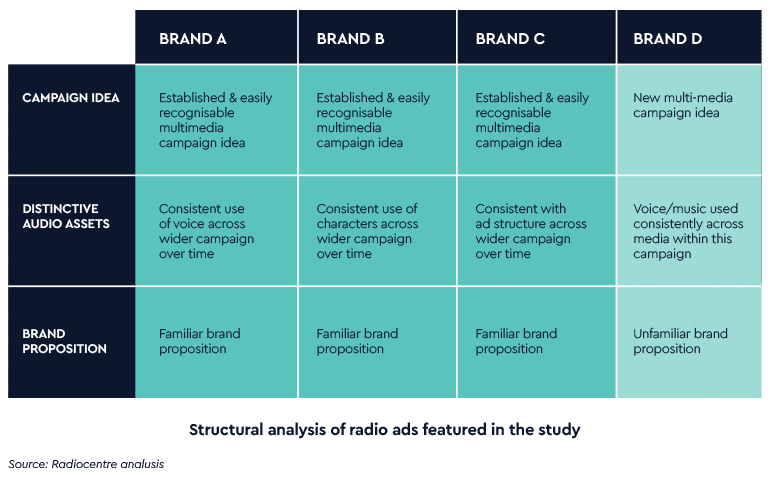
References
The Smart Shelf: Your Pathway to Winning in Retail
Nielsen, 2020
The Power of You
IPSOS, 2020
Neuro-Insight, 2019
Effectiveness in Context
IPA, 2018
Ebiquity, 2018
Differentology, 2016
Holmes and Cook, 2013
DRG, ongoing
Context Targeter Tool
Accessible via Radiocentre.org
Accessible via Radiocentre.org



